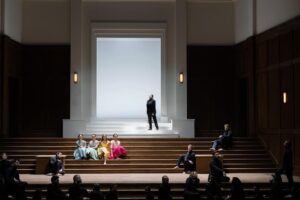
Salzburg Festival 2023 Review: Orfeo ed Euridice
Cecilia Bartoli & Mélissa Petit Shine in Solid Production
By João Marcos Copertino(Credit: Photo © SF/Bernd Uhlig)
When Cecilia Bartoli enters the stage, all eyes are on her. The leading headliner in Salzburg has made herself a living legend.
I know many music-lovers, of all ages, who have fallen in love with opera first and foremost because of Cecilia. Such talent has made legions of fans—myself included— to feel entitled to use her first name, even though we have never exchanged words.
After so many years in the spotlight, Bartoli has gained so much goodwill that her audience is open to seeing her musical explorations without any reservations. In this production of Gluck’s “Orfeo and Eurydice,” Bartoli is, in her own way, trying to reinvent herself. It is not a full twist, but a process of a decade or so. I think it started when she recorded such an idiosyncratic “Norma” in 2013. The singer who once was known as the most virtuoso singer of her generation, moved from fast coloraturas and vast color palates towards a more dramatically charged, but also more subtle, approach to music.
Bartoli Herself
Bartoli’s Orfeo is, after all, Bartoli herself. In Christof Loy’s staging, she sports a black suit with her hair tied in the back—the definition of visual austerity. It makes much sense that Orfeo could not be anyone else but Bartoli, a singer named after the patron saint of music. Her voice, slightly richer in higher harmonics than before, worked with a significantly more subtle color palette. Her tempi were very surprising, giving to the text a comprehensibility that made the show even more fluid. Her “Che faro senza Euridice” was severe, but not fastidious. Here, Orfeo’s sorrow is the center of the spectacle; unlike the Orfeo of many other singers, he seems to take no pleasure in making such fine music: his art is less important than his Eurydice. An Orfeo free of any narcissistic investment in his own suffering, he is a dramatically committed character, much like Bartoli herself.
Soprano Mélissa Petit was a particularly striking Eurydice. Her voice, a full lyric soprano, is more rounded than most singers singing Gluck lately. She used her tone to create an Eurydice that is less an ideal of a woman, and more of a real figure who therefore has much charisma—she is warm, but also has dramatical urgency. There is nothing symbolic in her search for Orfeo’s eyes; indeed, it was almost physical confrontation. Her death moments were particularly compelling dramatically; her voice, never losing its tone, faded convincingly.
However, it seems that was Loy and Capuano’s decision to omit most of the third act—and Eurydice’s second resurrection—enhancing, then, the tragic atmosphere of the opera. Instead of a happy ending, we hear a repetition of the mourning chorus of the first act. A mischievous outcome of such scenic distinction is the omission of the third act is the reduced opportunity for soprano Madison Nonoa to showcase her soprano. Her first act aria was efficient and served a dramatical purpose and I look forward to listening Nonoa in the future.
The Parma Version
The layout of the performance is extremely fluid—without any breaks and that I believe has a lot to do with the “Parma” version’s efficiency. There are many versions of Gluck’s masterpiece, and it makes sense that Gianluca Capuano would choose such a version given its dramatic fluidity and restless solutions. The excellent “Les Musiciens du Prince” from Monaco contributed to the making of such an intense dramatical experience.
The sounds were harsh and sharpening. More than an orchestra that merely escorts the singers, we have an active actor who sets the dramatic tension. Such a sharp approach never disrupts the melodic lines; the flute solo in the second act, for example, was extremely clear, played with a certainty and beauty that inebriated the House of Mozart. The Chorus “Il Canto de Orfeo,” always set facing the public, at the edge between the orchestra pit and the parterre, was also sonorous and elevated the music level.
Christof Loy’s choreography attempted to rescue a gestural language for suffering. The movements seek to make language happen without words; the gestures are vast but accessible. The ballet was extremely compelling in the second act, with great synchrony between what happens on the stage in all its layers. The scenario, by Ursula Renzenbrink (and white lights by Olaf Winter), returns the opera to its chamber space. Instead of great scenarios mimicking the Tartarus, we have a hall that can be a palace room or even a very fancy funeral house.
The result rescued a certain visual conception and reinvented how one sees the opera: a theater where the curtains never come down or open. A world where the singers are, intentionally, indistinguishable from the characters they are playing.


